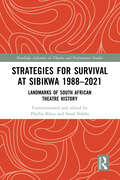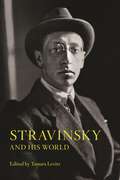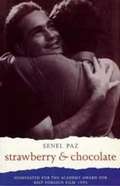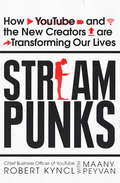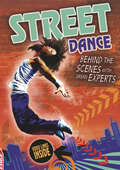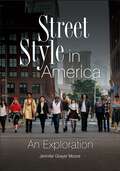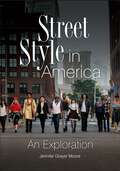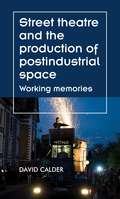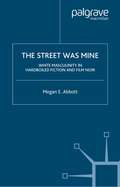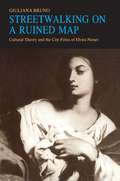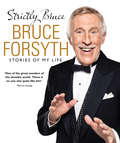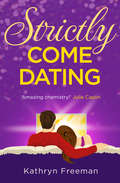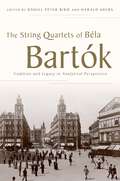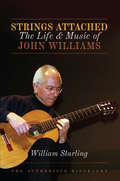- Table View
- List View
Strategies for Survival at SIBIKWA 1988 – 2021: Landmarks of South African Theatre History (Routledge Advances in Theatre & Performance Studies)
by Phyllis Klotz Smal NdabaThis book provides an engaging and contextualised insight into a South African township-based arts centre that has survived the vicissitudes of steady militarisation in townships during some of the worst years of apartheid as well as the exhilaration of a new democratic policy while attempting to circumnavigate different policies and funding dispensations. Sibikwa provides arts centres across the world and especially those in decolonising countries with strategies for survival in tumultuous times. This multi-disciplinary book maps and co-ordinates wider historical, political, and social contextual concerns and events with matters specific to a community-based east of Johannesburg and provides an exploration and analysis by experts of authentic theatre-making and performance, dance, indigenous music, arts in education and NGO governance. It has contemporary significance and raises important questions regarding inclusivity and transformation, the function and future of arts centres, community-based applied arts practices, creativity, and international partnerships. This study will be of great interest to students and scholars in theatre and performance, indigenous music, dance, and South African history.
Stravinsky and His World
by Tamara LevitzStravinsky and His World brings together an international roster of scholars to explore fresh perspectives on the life and music of Igor Stravinsky. Situating Stravinsky in new intellectual and musical contexts, the essays in this volume shed valuable light on one of the most important composers of the twentieth century. Contributors examine Stravinsky's interaction with Spanish and Latin American modernism, rethink the stylistic label "neoclassicism" with a section on the ideological conflict over his lesser-known opera buffa Mavra, and reassess his connections to his homeland, paying special attention to Stravinsky's visit to the Soviet Union in 1962. The essays also explore Stravinsky's musical and religious differences with Arthur Lourié, delve into Stravinsky's collaboration with Pyotr Suvchinsky and Roland-Manuel in the genesis of his groundbreaking Poetics of Music, and look at how the movement within stasis evident in the scores of Stravinsky's Orpheus and Oedipus Rex reflected the composer's fierce belief in fate. Rare documents--including Spanish and Mexican interviews, Russian letters, articles by Arthur Lourié, and rarely seen French and Russian texts--supplement the volume, bringing to life Stravinsky's rich intellectual milieu and intense personal relationships. The contributors are Tatiana Baranova, Leon Botstein, Jonathan Cross, Valérie Dufour, Gretchen Horlacher, Tamara Levitz, Klára Móricz, Leonora Saavedra, and Svetlana Savenko.
Stravinsky and His World
by Tamara LevitzStravinsky and His World brings together an international roster of scholars to explore fresh perspectives on the life and music of Igor Stravinsky. Situating Stravinsky in new intellectual and musical contexts, the essays in this volume shed valuable light on one of the most important composers of the twentieth century. Contributors examine Stravinsky's interaction with Spanish and Latin American modernism, rethink the stylistic label "neoclassicism" with a section on the ideological conflict over his lesser-known opera buffa Mavra, and reassess his connections to his homeland, paying special attention to Stravinsky's visit to the Soviet Union in 1962. The essays also explore Stravinsky's musical and religious differences with Arthur Lourié, delve into Stravinsky's collaboration with Pyotr Suvchinsky and Roland-Manuel in the genesis of his groundbreaking Poetics of Music, and look at how the movement within stasis evident in the scores of Stravinsky's Orpheus and Oedipus Rex reflected the composer's fierce belief in fate. Rare documents--including Spanish and Mexican interviews, Russian letters, articles by Arthur Lourié, and rarely seen French and Russian texts--supplement the volume, bringing to life Stravinsky's rich intellectual milieu and intense personal relationships. The contributors are Tatiana Baranova, Leon Botstein, Jonathan Cross, Valérie Dufour, Gretchen Horlacher, Tamara Levitz, Klára Móricz, Leonora Saavedra, and Svetlana Savenko.
Straw Dogs (Controversies)
by Stevie SimkinSam Peckinpah's Straw Dogs ignited fierce debate among censors, critics and audiences on both sides of the Atlantic on its release in 1971. When Amy (Susan George) returns to her home village with her American peacenik husband David (Dustin Hoffman), the residents of this tight-knit Cornish community slowly turn on them. The sexual tension and latent violence finally erupt in an explosion of violence that includes a rape scene that has remained controversial to this day. The film was heavily cut for theatrical release in the US, and the pressinspired furore in the UK led to several local councils cutting or banning it outright. Later, caught in the wake of the 'video nasties' panic of the 1980s, Straw Dogs was refused a home-video certificate in the UK for nearly twenty years.Stevie Simkin's study sheds light on the film's treatment by the British Board of Film Classification (BBFC) and tracks its subsequent tortuous journey towards home-video release, buffeted by various shifts in the BBFC's policy on representations of sexual violence. But, equally importantly, Simkin provides a highly original accountof themaking of the film, drawing on extensive research in Peckinpah's archive, including analysis of draft scripts, notes, memos and contemporary press items, as well as insights from a number of Peckinpah's associates, and key figures at the BBFC.'A swift, compelling read. Thorough and scholarly without the faintest whiff of academic stuffiness, Stevie Simkin's study of Straw Dogs summons up the turmoil of the 1960s and 70s and illuminates the highly charged subject of sexual violence on film.'Stephen Farber, Film Critic, The Hollywood ReporterStevie Simkin is Reader in Drama and Film at the University of Winchester, UK. He is the author of, among other works, Revenge Tragedy: A New Casebook (2001), Early Modern Tragedy and the Cinema of Violence (2005), and, also in the Controversies series, a volume on Basic Instinct (forthcoming, 2013).
Straw Dogs (Controversies)
by Stevie SimkinSam Peckinpah's Straw Dogs ignited fierce debate among censors, critics and audiences on both sides of the Atlantic on its release in 1971. When Amy (Susan George) returns to her home village with her American peacenik husband David (Dustin Hoffman), the residents of this tight-knit Cornish community slowly turn on them. The sexual tension and latent violence finally erupt in an explosion of violence that includes a rape scene that has remained controversial to this day. The film was heavily cut for theatrical release in the US, and the pressinspired furore in the UK led to several local councils cutting or banning it outright. Later, caught in the wake of the 'video nasties' panic of the 1980s, Straw Dogs was refused a home-video certificate in the UK for nearly twenty years.Stevie Simkin's study sheds light on the film's treatment by the British Board of Film Classification (BBFC) and tracks its subsequent tortuous journey towards home-video release, buffeted by various shifts in the BBFC's policy on representations of sexual violence. But, equally importantly, Simkin provides a highly original accountof themaking of the film, drawing on extensive research in Peckinpah's archive, including analysis of draft scripts, notes, memos and contemporary press items, as well as insights from a number of Peckinpah's associates, and key figures at the BBFC.'A swift, compelling read. Thorough and scholarly without the faintest whiff of academic stuffiness, Stevie Simkin's study of Straw Dogs summons up the turmoil of the 1960s and 70s and illuminates the highly charged subject of sexual violence on film.'Stephen Farber, Film Critic, The Hollywood ReporterStevie Simkin is Reader in Drama and Film at the University of Winchester, UK. He is the author of, among other works, Revenge Tragedy: A New Casebook (2001), Early Modern Tragedy and the Cinema of Violence (2005), and, also in the Controversies series, a volume on Basic Instinct (forthcoming, 2013).
Strawberry And Chocolate: Introduction, translations & interview by Peter Bush
by Senel Paz Peter Bush[Amazon] The central relationship between Diego, the gay Cuban intellectual, and David a young communist militant, is developed by writer Senel Paz from his prize-winning short story "The Wolf, the Woods and the New Man". Introduction, translations & interview by Peter Bush
The Strawberry Hill Set: Horace Walpole and His Circle
by Brian FothergillTo Horace Walpole's house at Strawberry Hill, in Twickenham, came a remarkable assortment of poets and writers, artists and antiquaries, politicians and society figures. Among them were Thomas Gray, whose great 'Elegy' might never have been published without Walpole's encouragement; that 'laughter-loving dame' Kitty Clive, the greatest comic actress of her day; Lady Suffolk who entertained Walpole with stories of the days when she was George II's mistress; the epicene John Chute, whose architectural knowledge and enthusiasm helped to inspire Strawberry Hill; the gentle Berry sisters, who comforted Walpole's old age; George Selwyn, celebrated for his wit, languor, and necrophilia. 'If Mr Selwyn calls', said Mr Fox on his death-bed, 'show him up. If I'm still alive I'll be glad to see him and if I'm dead he'll be glad to see me.' The most fascinating member of this circle was Horace Walpole himself. Son of Sir Robert, Member of Parliament for many years, author of the first Gothic romance, The Castle of Otranto, passionate collector, influential amateur of architecture and, above all, prince of English letter-writers, he emerges gradually but clearly through the eyes of his friends. Brian Fothergill, always an accomplished biographer, perhaps found his most congenial subject in this book: the result is a work as entertaining as it is informative.
Stray Dog of Anime: The Films of Mamoru Oshii
by B. RuhUpon its US release in the mid 1990s, Ghost in the Shell , directed by Mamoru Oshii, quickly became one of the most popular Japanese animated films in the country. Despite this, Oshii is known as a maverick within anime: a self-proclaimed 'stray dog'. This is the first book to take an in-depth look at his major films, from Urusei Yatsura to Avalon .
Stray Dog of Anime: The Films of Mamoru Oshii
by B. RuhUpon its U.S. release in the mid 1990s Ghost in the Shell , directed by Mamoru Oshii, quickly became one of the most popular Japanese animated films, or anime, in the country. Despite these accolades, Oshii is known as a contrarian within anime, a self-proclaimed 'stray dog', avoiding the limelight in favour of his own personal cinematic vision. He cannot be pigeon-holed, working in both live-action film and animation, directing everything from absurdist comedy to thrillers to meditations on the nature of reality. Stray Dog of Anime is the first book to take an in-depth look at Oshii's major films, form his early days working on Urusei Yatsura to Avalon , his most recent feature. Ruh details Oshii's evolution as a director, paying special attention to his personal style and symbolism, resulting in a unique guide that will appeal to anime fans and cinestes of all kinds.
Streaming and Screen Culture in Asia-Pacific
by Michael Samuel Louisa MitchellThis book is an interdisciplinary collection exploring the impact of emergent technologies on the production, distribution and reception of media content in the Asia-Pacific region. Exploring case studies from China, Japan, South Korea, India, Thailand and Australia, as well as American co-productions, this collection takes a Cultural Studies approach to the constantly evolving ways of accessing and interacting with visual content. The study of the social and technological impact of online on-demand services is a burgeoning field of investigation, dating back to the early-2010s. This project will be a valuable update to existing conversations, and a cornerstone for future discussions about topics such as online technologies, popular culture, soft power, and social media.
Streampunks: How YouTube and the New Creators are Transforming Our Lives
by Robert Kyncl Maany Peyvan***Axiom Business Book Award Winner!***Something massive is shifting in the world of entertainment.Across the planet, humans spend more of their free time watching video than doing anything else. But increasingly it’s not TV they're watching, but online video. In 2016, Swedish vlogger PewDiePie made a record $15 million from his YouTube videos, beating Hollywood A-listers like Harrison Ford, Julia Roberts and Amy Adams. Something massive is shifting in the world of entertainment. Since its founding in 2005, YouTube has become the first and only truly global media platform, with over a billion users worldwide. It has changed the media industry as profoundly as the development of radio, film and television. In Streampunks, YouTube’s Chief Business Officer Robert Kyncl gets to the heart of this creative revolution through behind-the-scenes stories of its biggest stars – YouTubers like Tyler Oakley, Lilly Singh, and Casey Neistat—and the dealmakers brokering the future of media, like Scooter Braun, who scouted 12-year old Justin Bieber on YouTube, and Vice media mogul Shane Smith who used the platform to turn young people onto news and current affairs.By giving anyone with a smartphone their own TV channel, YouTube is fuelling a new creative boom. Not only is it generating the new faces of entertainment, but also changing how students are taught, how social issues are discussed and how small businesses advertise and develop.Streampunks is the definitive book on the modern pop-culture juggernaut Youtube, the platform remaking the face of entertainment.
Street Dance (EDGE: Street #1)
by Rita StoreyThis is your chance to get the inside track on the hottest street scenes today. - Incredible dance moves- Hot video links- Inspirational photos- Q & As- Star performers- Competitions- Dance stylesEverything you need to be a street dance star of the future!
Street Style in America: An Exploration
by Dr Jennifer Grayer MooreA comprehensive resource that will prove invaluable to fashion historians, this book presents a detailed exploration of the breadth of visually arresting, consumer-driven styles that have emerged in America since the 20th century.What are the origins of highly specific denim fashions, such as bell bottoms, skinny jeans, and ripped jeans? How do mass media and popular culture influence today's street fashion? When did American fashion sensibilities shift from conformity as an ideal to youth-oriented standards where clothing could boldly express independence and self-expression? Street Style in America: An Exploration addresses questions like these and many others related to the historical and sociocultural context of street style, supplying both A–Z entries that document specific American street styles and illustrations with accompanying commentary.This book provides a detailed analysis of American street and subcultural styles, from the earliest example reaching back to the early 20th century to contemporary times. It reviews all aspects of dress that were part of a look, considering variations over time and connecting these innovations to fashionable dress practices that emerged in the wakes of these sartorial rebellions. The text presents detailed examinations of specific dress styles and also interrogates the manifold meanings of dress practices that break from the mainstream. This book is a comprehensive resource that will prove invaluable to fashion historians and provide fascinating reading for students and general audiences.
Street Style in America: An Exploration
by Dr Jennifer Grayer MooreA comprehensive resource that will prove invaluable to fashion historians, this book presents a detailed exploration of the breadth of visually arresting, consumer-driven styles that have emerged in America since the 20th century.What are the origins of highly specific denim fashions, such as bell bottoms, skinny jeans, and ripped jeans? How do mass media and popular culture influence today's street fashion? When did American fashion sensibilities shift from conformity as an ideal to youth-oriented standards where clothing could boldly express independence and self-expression? Street Style in America: An Exploration addresses questions like these and many others related to the historical and sociocultural context of street style, supplying both A–Z entries that document specific American street styles and illustrations with accompanying commentary.This book provides a detailed analysis of American street and subcultural styles, from the earliest example reaching back to the early 20th century to contemporary times. It reviews all aspects of dress that were part of a look, considering variations over time and connecting these innovations to fashionable dress practices that emerged in the wakes of these sartorial rebellions. The text presents detailed examinations of specific dress styles and also interrogates the manifold meanings of dress practices that break from the mainstream. This book is a comprehensive resource that will prove invaluable to fashion historians and provide fascinating reading for students and general audiences.
Street theatre and the production of postindustrial space: Working memories (Theatre: Theory – Practice – Performance)
by David CalderDeindustrialising communities have called upon street theatre companies to re-animate public space and commemorate industrial heritage. How have these companies converted derelict factories into spaces of theatrical production? How do they connect their work to the industrial work that once occurred there? How do those connections manifest in theatrical events, and how do such events give shape and meaning to ongoing redevelopment projects? This book develops an understanding of the relationship between theatre and redevelopment that goes beyond accusations of gentrification or celebrations of radical resistance. Ultimately, Calder argues that deindustrialisation and redevelopment depend on theatrical events and performative acts to make ongoing change intelligible and navigable.Working memories brings together some of current theatre scholarship’s fundamental concerns while demonstrating the significance of those concerns to an interdisciplinary readership.
Street theatre and the production of postindustrial space: Working memories (Theatre: Theory – Practice – Performance)
by David CalderDeindustrialising communities have called upon street theatre companies to re-animate public space and commemorate industrial heritage. How have these companies converted derelict factories into spaces of theatrical production? How do they connect their work to the industrial work that once occurred there? How do those connections manifest in theatrical events, and how do such events give shape and meaning to ongoing redevelopment projects? This book develops an understanding of the relationship between theatre and redevelopment that goes beyond accusations of gentrification or celebrations of radical resistance. Ultimately, Calder argues that deindustrialisation and redevelopment depend on theatrical events and performative acts to make ongoing change intelligible and navigable.Working memories brings together some of current theatre scholarship’s fundamental concerns while demonstrating the significance of those concerns to an interdisciplinary readership.
Street theatre and the production of postindustrial space: Working memories (Theatre: Theory – Practice – Performance)
by David CalderDeindustrialising communities have called upon street theatre companies to re-animate public space and commemorate industrial heritage. How have these companies converted derelict factories into spaces of theatrical production? How do they connect their work to the industrial work that once occurred there? How do those connections manifest in theatrical events, and how do such events give shape and meaning to ongoing redevelopment projects? This book develops an understanding of the relationship between theatre and redevelopment that goes beyond accusations of gentrification or celebrations of radical resistance. Ultimately, Calder argues that deindustrialisation and redevelopment depend on theatrical events and performative acts to make ongoing change intelligible and navigable.Working memories brings together some of current theatre scholarship’s fundamental concerns while demonstrating the significance of those concerns to an interdisciplinary readership.
Street theatre and the production of postindustrial space: Working memories (Theatre: Theory – Practice – Performance)
by David CalderDeindustrialising communities have called upon street theatre companies to re-animate public space and commemorate industrial heritage. How have these companies converted derelict factories into spaces of theatrical production? How do they connect their work to the industrial work that once occurred there? How do those connections manifest in theatrical events, and how do such events give shape and meaning to ongoing redevelopment projects? This book develops an understanding of the relationship between theatre and redevelopment that goes beyond accusations of gentrification or celebrations of radical resistance. Ultimately, Calder argues that deindustrialisation and redevelopment depend on theatrical events and performative acts to make ongoing change intelligible and navigable.Working memories brings together some of current theatre scholarship’s fundamental concerns while demonstrating the significance of those concerns to an interdisciplinary readership.
The Street Was Mine: White Masculinity in Hardboiled Fiction and Film Noir
by M. AbbottThis book considers a recurrent figure in American literature: the solitary white man moving through urban space. The descendent of Nineteenth-century frontier and western heroes, the figure re-emerges in 1930-50s America as the 'tough guy'. The Street Was Mine looks to the tough guy in the works of hardboiled novelists Raymond Chandler ( The Big Sleep ) and James M. Cain ( Double Indemnity ) and their popular film noir adaptations. Focusing on the way he negotiates racial and gender 'otherness', this study argues that the tough guy embodies the promise of an impervious white masculinity amidst the turmoil of the Depression through the beginnings of the Cold War, closing with an analysis of Chester Himes, whose Harlem crime novels ( For Love of Imabelle ) unleash a ferocious revisionary critique of the tough guy tradition.
Streetwalking on a Ruined Map: Cultural Theory and the City Films of Elvira Notari
by Giuliana BrunoEmphasizing the importance of cultural theory for film history, Giuliana Bruno enriches our understanding of early Italian film as she guides us on a series of "inferential walks" through Italian culture in the first decades of this century. This innovative approach---the interweaving of examples of cinema with architecture, art history, medical discourse, photography, and literature--addresses the challenge posed by feminism to film study while calling attention to marginalized artists. An object of this critical remapping is Elvira Notari (1875-1946), Italy's first and most prolific woman filmmaker, whose documentary-style work on street life in Naples, a forerunner of neorealism, was popularly acclaimed in Italy and the United States until its suppression during the Fascist regime. Since only fragments of Notari's films exist today, Bruno illuminates the filmmaker's contributions to early Italian cinematography by evoking the cultural terrain in which she operated. What emerges is an intertextual montage of urban film culture highlighting a woman's view on love, violence, poverty, desire, and death. This panorama ranges from the city's exteriors to the body's interiors. Reclaiming an alternative history of women's filmmaking and reception, Bruno draws a cultural history that persuasively argues for a spatial, corporal interpretation of film language.
Streetwalking on a Ruined Map: Cultural Theory and the City Films of Elvira Notari
by Giuliana BrunoEmphasizing the importance of cultural theory for film history, Giuliana Bruno enriches our understanding of early Italian film as she guides us on a series of "inferential walks" through Italian culture in the first decades of this century. This innovative approach---the interweaving of examples of cinema with architecture, art history, medical discourse, photography, and literature--addresses the challenge posed by feminism to film study while calling attention to marginalized artists. An object of this critical remapping is Elvira Notari (1875-1946), Italy's first and most prolific woman filmmaker, whose documentary-style work on street life in Naples, a forerunner of neorealism, was popularly acclaimed in Italy and the United States until its suppression during the Fascist regime. Since only fragments of Notari's films exist today, Bruno illuminates the filmmaker's contributions to early Italian cinematography by evoking the cultural terrain in which she operated. What emerges is an intertextual montage of urban film culture highlighting a woman's view on love, violence, poverty, desire, and death. This panorama ranges from the city's exteriors to the body's interiors. Reclaiming an alternative history of women's filmmaking and reception, Bruno draws a cultural history that persuasively argues for a spatial, corporal interpretation of film language.
Strictly Bruce: Stories Of My Life
by Bruce ForsythBruce Forsyth, the consummate performer and much-loved face of British entertainment, shares his story of a remarkable life lived to the full. A dancer, comedian, singer, actor, musician and all-round entertainer, Bruce achieved national recognition as the host of Sunday Night at the London Palladium in the 1950s. With his classic one-man shows, appearances alongside some of the world’s greatest performers, and hugely popular TV shows ranging from The Generation Game to Strictly Come Dancing, he was a household name renowned for putting a smile on the nation’s face.Charting his life story from talented young lad growing up in north London to achieving national treasure status, Strictly Bruce is full of warm anecdotes spanning over eight decades of Bruce’s life, man and boy. It’s a chance to take a trip down memory lane, celebrate the golden age of British showbiz and step behind the scenes of Bruce’s personal life, meeting the people he loved and learning what made him tick.
Strictly Come Dating (The Kathryn Freeman Romcom Collection #3)
by Kathryn FreemanFun, feel-good and a must read for fans of Strictly Come Dancing!
The String Quartets of Béla Bartók: Tradition and Legacy in Analytical Perspective
Béla Bartók (1881-1945) was one of the most important composers and musical thinkers of the 20th century. His contributions as a composer, as a performer and as the father of ethnomusicology changed the course of music history and of our contemporary perception of music itself. At the center of Bartók's oeuvre are his string quartets, which are generally acknowledged as some of the most significant pieces of 20th century chamber music. The String Quartets of Béla Bartók brings together innovative new scholarship from 14 internationally recognized music theorists, musicologists, performers, and composers to focus on these remarkable works from a range of theoretical and methodological perspectives. Focusing on a variety of aspects of the string quartets-harmony and tonality, form, rhythm and meter, performance and listening-it considers both the imprint of folk and classical traditions on Bartók's string quartets, and the ways in which they influenced works of the next generation of Hungarian composers. Rich with notated music examples the volume is complemented by an Oxford Web Music companion website offering additional notated as well as recorded examples. The String Quartets of Béla Bartók, reflecting the impact of the composer himself, is an essential resource for scholars and students across a variety of fields from music theory and musicology, to performance practice and ethnomusicology.
Strings Attached: The Life and Music of John Williams
by William StarlingStrings Attached is the much anticipated authorised biography of John Williams, one of the most accomplished and celebrated musicians of his generation. From his childhood in Australia to his stellar career in London and around the world, John Williams has lived an extraordinary life. Master of the classical repertoire, he took the guitar to a wider audience with the band SKY and by his championing of the music of South America and Africa. William Starling came to know John Williams through their mutual friend, jazz guitarist John Etheridge. As their friendship developed, he put it to the maestro that it was time for a biography. To his lasting amazement, the famously private Williams agreed. Strings Attached is the product of extensive research and uniquely privileged access to John Williams, his family, friends and musical associates. It is the first telling of the fascinating life and career of a world-renowned musician and, equally, the story of a man and the making of his identity.
